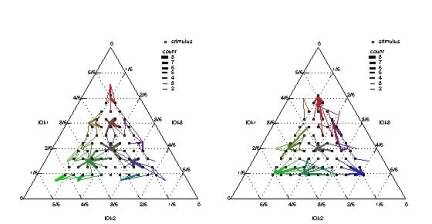
P. Desain (1), C. Jansen (1), and H. Honing (1, 2)
(1) Music Mind Machine Group, NICI, Nijmegen University
(2) Music Department, University of Amsterdam
[published as: Desain, P., Jansen, C., and Honing, H. (2000) How identification of rhythmic categories depends on tempo and meter. In Proceedings of the Sixth International Conference on Music Perception and Cognition Keele, UK: Keele University, Department of Psychology]
In previous work we elaborated a way to systematically investigate the perceptual division of a continuous space of temporal patterns into discrete rhythmic categories (Aarts, Desain & Jansen, in preparation; Aarts & Jansen, 1999). We studied the perception of short rhythmical patterns by sampling the space of all possible patterns of three interonset-intervals (IOI), with a total duration of one second. For this, musicians were asked to transcribe these short patterns of three IOIs (i.e. four onsets) into music notation. It was shown that subjects were able to identify rhythmic categories as regions of the rhythm space. Next to an insight in the perception of rhythmic categories, the results are essential in the design and construction of automatic music transcription systems (see Cemgil, Desain & Kappen, in press).
The current study was conducted to clarify how the shape of the rhythmic categories depends on metric context and global tempo. Previous studies (e.g., Clarke, 1987; Schulze, 1989) already addressed the effect of tempo and meter. However, these results were not unequivocal. Also, generalization was limited due to a relatively small set of stimuli and a predefined set of responses (arguably steering the subject to the available categories).
In this study we elaborated on the paradigm used in earlier studies of systematically sampling the space of temporal patterns using open responses. To investigate the context effects of tempo and meter we conducted two experiments in which a total of seventeen conservatory-trained musicians transcribed aurally presented rhythmic patterns by means of a simple computer interface for music notation.
In the first experiment the rhythms were presented at three tempi (40, 60, 90 BPM). The total stimulus consisted of nine beats, marking eight measures. In the 3rd, 5th and 7th measure the rhythmical pattern was presented. The length of a measure was resp. 0.67, 1.0 and 1.5 seconds in the three tempo conditions. The beat and pattern were marked with different sounds (resp. high and low congo).
In the second experiment, the same patterns were presented in the context of a duple meter and a triple meter, at 60 BPM. The stimulus consisted of nine beats, marking eighth measures. Each beat was divided in two (for duple meter) or three (for triple meter) intervals marked with a softer sub-beat. In the 3rd, 5th and 7th measure the rhythmical pattern was presented.
The results of the first experiment show how the rhythmical regions change shape in the different tempi, depending on their complexity. In the second experiment, different rhythmic categories were given as response depending on the metrical context, again in accordance with the relative rhythmic complexity of the patterns in these meters. Metrical context determines what rhythmical categories occur (see Figure 1), and tempo affects the size and shape of these categories. Notwithstanding these clear results, the variance of the data between subjects reflects the complexity of decision making by musicians in quantizing rhythmical patterns. The consequences of these findings for existing models of rhythmic quantization are the topic of further research.

Figure 1: Ternary plot of the responses (drawn as a line from stimulus to response; line-width indicates the number of equal responses) for 66 stimuli (open circles) consisting of three IOIs presented in a duple meter context (left) and in a triple meter context (right). The direction of a tick mark indicates to which grid line it belong. For example, the stimulus in the middle of the rhythm space is 1/3-1/3-1/3 or 1:1:1). These results show that metric context has a strong effect on perceived rhythmic categories. For example, the rhythmic category 2:1:1 is only present in duple context, 1:3:2 only in the triple condition.
This research has been made possible by the Netherlands Organization for Scientific Research (NWO) as part of the "Music, Mind, Machine" project. More information can be found at https://www.nici.kun.nl/mmm.
Aarts, R. and Jansen, C. (1999) Categorical perception of short rhythms. In Proceedings of the 1999 SMPC, pp 57. Evanston.
Aarts, R., Desain, P., and Jansen, C. (In Preparation) The quantization of short rhythmical patterns.
Cemgil, T., Desain, P., and Kappen, B. (In Press) Rhythm quantization for transcription. Computer Music Journal.
Clarke, E. F. (1987). Categorical rhythm perception: an ecological perspective. A. Gabrielson (Ed.), Action and Perception in Rhythm and Music. Royal Swedish Academy of Music, 55.
Schulze, H. H. (1989). Categorical perception of rhythmic patterns. Psychological Research, 51, pp 2-9.